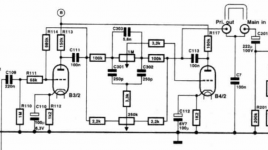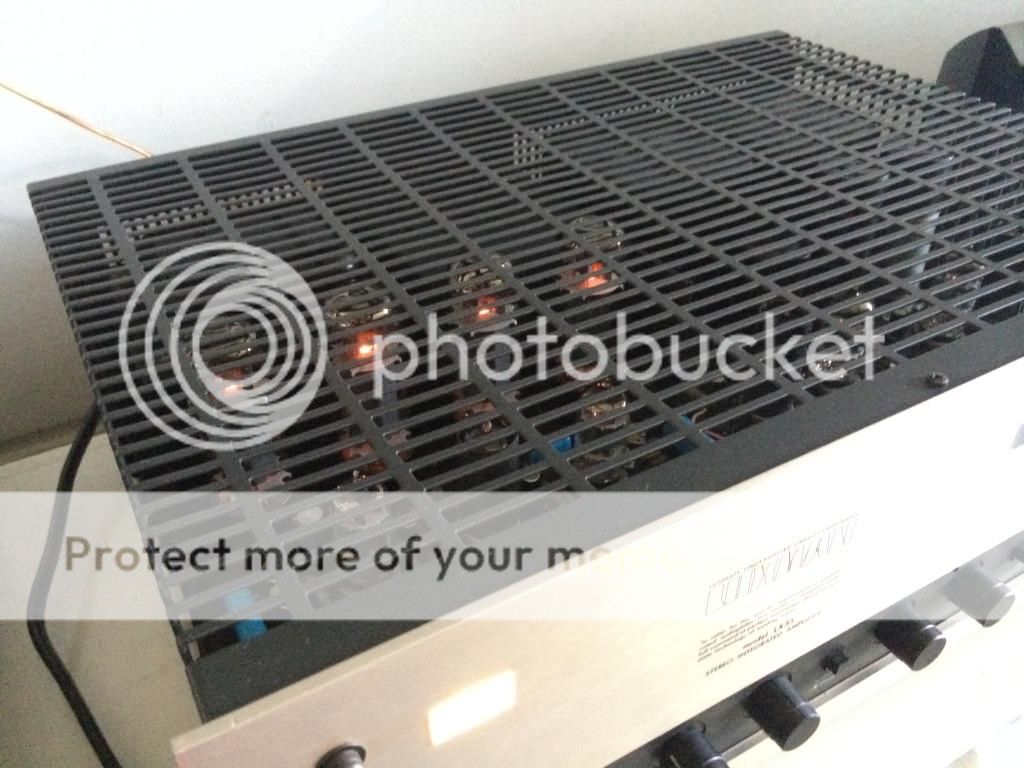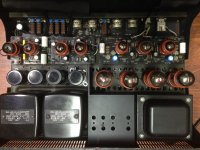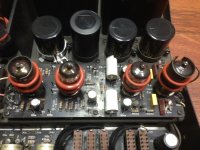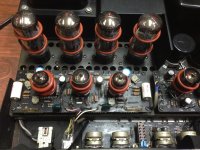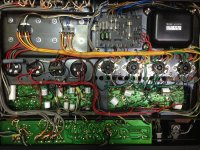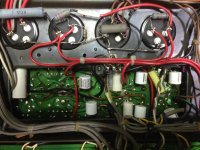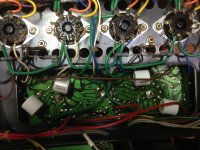Hi all,
I have an old Luxman LX33 which have considerably noise at the output (around 20mVAC, measured by my Agilent 34401A).
Traced around and I found oscillations at the Preamp outputs (actually the Baxandal-type tone stack): same frequency, amplitude and characteristics for both channels. The oscillations are at approx. 37kHz with amplitude rise and fall pretty fast (several times/second) from 0 to about 4mVpp (bass & treble controls at 50%; volume at min.).
So far I have tried and observed the following, but the result is still fruitless:
- swap/replace the 12AX7
- disconnect the amp's PSU, power the tonestack with separated HT & heater supplies
- oscillations seem to appear somewhere the output triodes
- amplitudes of the oscillations is at minimum (approx. zero) when Treble knob at min. and Bass knob at either min. or max; max amplitude is achieved at max. Treble and 50% Bass
Now I'm stuck here, please help me solving this.
Attached is the schematic of the entire amp and the tonestack (B+ for the tonestack is approx. 300VDC).
Thanks,
Duong
I have an old Luxman LX33 which have considerably noise at the output (around 20mVAC, measured by my Agilent 34401A).
Traced around and I found oscillations at the Preamp outputs (actually the Baxandal-type tone stack): same frequency, amplitude and characteristics for both channels. The oscillations are at approx. 37kHz with amplitude rise and fall pretty fast (several times/second) from 0 to about 4mVpp (bass & treble controls at 50%; volume at min.).
So far I have tried and observed the following, but the result is still fruitless:
- swap/replace the 12AX7
- disconnect the amp's PSU, power the tonestack with separated HT & heater supplies
- oscillations seem to appear somewhere the output triodes
- amplitudes of the oscillations is at minimum (approx. zero) when Treble knob at min. and Bass knob at either min. or max; max amplitude is achieved at max. Treble and 50% Bass
Now I'm stuck here, please help me solving this.
Attached is the schematic of the entire amp and the tonestack (B+ for the tonestack is approx. 300VDC).
Thanks,
Duong
Attachments
Might be too much gain in B4/2.
Try removing C112 to reduce gain a bit.
I see B+ for tone stack goes to two valves.
I usually separate the B+ to stop feedback between stages.
Try removing C112 to reduce gain a bit.
I see B+ for tone stack goes to two valves.
I usually separate the B+ to stop feedback between stages.
Given the age of this unit (30+ yrs) I would replace the power supply cap feeding the tone stack before proceeding with any modifications. I would probably replace all supply caps at this point.
Reducing the gain in either stage is going to seriously impact the performance of tone stack, in particular source impedance due to reduced OLG in the first stage and in the second stage would impact the contour as well as distortion characteristics of the tone control.
I am sure the amplifier worked properly at one point, and something is now broken - diagnose and fix that. Check for audio (37kHz osc for example) on the supply to the tone stage. Modify only after original problem is understood and solved.
Reducing the gain in either stage is going to seriously impact the performance of tone stack, in particular source impedance due to reduced OLG in the first stage and in the second stage would impact the contour as well as distortion characteristics of the tone control.
I am sure the amplifier worked properly at one point, and something is now broken - diagnose and fix that. Check for audio (37kHz osc for example) on the supply to the tone stage. Modify only after original problem is understood and solved.
Might be too much gain in B4/2.
Try removing C112 to reduce gain a bit.
I see B+ for tone stack goes to two valves.
I usually separate the B+ to stop feedback between stages.
What Kevin says.
I was in design mode !
You should be replacing all electrolytics if it is of any age.
Given the age of this unit (30+ yrs) I would replace the power supply cap feeding the tone stack before proceeding with any modifications. I would probably replace all supply caps at this point.
Reducing the gain in either stage is going to seriously impact the performance of tone stack, in particular source impedance due to reduced OLG in the first stage and in the second stage would impact the contour as well as distortion characteristics of the tone control.
I am sure the amplifier worked properly at one point, and something is now broken - diagnose and fix that. Check for audio (37kHz osc for example) on the supply to the tone stage. Modify only after original problem is understood and solved.
Thanks all for your ideas,
Indeed since oscillations appear on both channels with similar characteristics, the first thing I suspected is the supply, hence I replaced both heater and HT with my bench PSUs but it didn't eliminate the oscillations.
However, I accidentally found out that the oscillations came from the ballast of a florescence lamp on my bench!!! Right after I turned off the light, all the oscillations disappeared. Quite embarrassing haiz.
Nevertheless, listening test still showed audible noise from the tone stage (noise disappeared when I shorted the PA input to gnd), so the issue is still there. PSU caps replacement is on the list again, but the original ones are triple sections 3x47uF/450WV & 3x47uF/550WV so replacement parts will be difficult.
(to be continue)
Ciao, hoang duong go
Pls check pcb Clear or not ?
Step by step replacing power tubes, driver , tone, input... For check osc signal
And , and,,, take my home if you want 🙂
B rgds
Thuylt from vnav
Pls check pcb Clear or not ?
Step by step replacing power tubes, driver , tone, input... For check osc signal
And , and,,, take my home if you want 🙂
B rgds
Thuylt from vnav
Hoang, I've had the same exact experience with an electronic ballast in a fluorescent lamp on my bench so I can commiserate! 😀
Glad you found it was an external disturbance..
Would still be advisable to replace the supply electrolytics, at best they are tired, at worst they could be a real liability.
Both JJ and FT make multi-section caps, you might find something that works well enough..
Glad you found it was an external disturbance..
Would still be advisable to replace the supply electrolytics, at best they are tired, at worst they could be a real liability.
Both JJ and FT make multi-section caps, you might find something that works well enough..
I had the same problem wit ha new SS design.
Oscillation everywhere.
My desk lamp had a CFL lamp in it and when I moved the lamp away the oscillation went.
Many years ago I designed an electronic dog flap.
It had a huge inductive loop in the door to read the dogs tag.
In the mornings it would work fine but in the afternoon it picked up oscillations.
Turned out next door turned their TV on in the afternoons and I was picking it up next door !
Oscillation everywhere.
My desk lamp had a CFL lamp in it and when I moved the lamp away the oscillation went.
Many years ago I designed an electronic dog flap.
It had a huge inductive loop in the door to read the dogs tag.
In the mornings it would work fine but in the afternoon it picked up oscillations.
Turned out next door turned their TV on in the afternoons and I was picking it up next door !
Case closed!
Luckily enough the LX33 has one spare hole for another PSU caps so I replaced the 2 triple-section (3x47uF) cans with 3 Mundorf 2x50uF/500V caps. The pesky noises are now almost gone.
I also found how sensitive the Mundorf EVO caps are, I used them to replace the original coupling caps in PA stage. Just removing the old caps and putting the new ones in place still leaves some back ground noises, but when I moved them to under the PC board, all the remaining noise went away.
Thanks all for your inputs as well 😉
Luckily enough the LX33 has one spare hole for another PSU caps so I replaced the 2 triple-section (3x47uF) cans with 3 Mundorf 2x50uF/500V caps. The pesky noises are now almost gone.
I also found how sensitive the Mundorf EVO caps are, I used them to replace the original coupling caps in PA stage. Just removing the old caps and putting the new ones in place still leaves some back ground noises, but when I moved them to under the PC board, all the remaining noise went away.
Thanks all for your inputs as well 😉
Hi Hoang.. What is the correct bias setting, because I just buy a Luxman LX33 today and i'm going to put on new matched quad of Mullard EL34 reissue,
Thanks
Sent from my iPhone using Tapatalk
Thanks
Sent from my iPhone using Tapatalk
Hi Norelco,
Currently I set the bias level of this LX-33 at approx. 35mA/tube, which is fine for me. But you can try and adjust to adapt your own preference, as long as the bias isn't too high or too low.
Regards,
Duong
Currently I set the bias level of this LX-33 at approx. 35mA/tube, which is fine for me. But you can try and adjust to adapt your own preference, as long as the bias isn't too high or too low.
Regards,
Duong
Hi Norelco,
Currently I set the bias level of this LX-33 at approx. 35mA/tube, which is fine for me. But you can try and adjust to adapt your own preference, as long as the bias isn't too high or too low.
Regards,
Duong
what is the plate voltage? knowing the idle dissipation is more helpful, it tells us how you are running the tube in terms of plate ratings, 70% more or less is typical...
hoang, can you post pictures?
Hi AJT,
Sorry I didn't take any photo when I serviced that amp, but I will take and post some when I open it again.
Btw, what parts of this amp that you are interested in (hence the photos)?
Thanks,
Duong
Hi Duong,
Is the bias pot located on the driver board? Sorry because the Amp just delivered yesterday and currently i'm still at work. I'm so excited to power up that amp. I'm going to pair it with Klipsch Forte II.
Sent from my iPhone using Tapatalk
Is the bias pot located on the driver board? Sorry because the Amp just delivered yesterday and currently i'm still at work. I'm so excited to power up that amp. I'm going to pair it with Klipsch Forte II.
Sent from my iPhone using Tapatalk
Hi Duong,
Is the bias pot located on the driver board? Sorry because the Amp just delivered yesterday and currently i'm still at work. I'm so excited to power up that amp. I'm going to pair it with Klipsch Forte II.
Sent from my iPhone using Tapatalk
Yes, but there are 3 trimpots per channel on that board, only 2 of them (VK202, 203) are for bias setting while the other one is for driver adjustment.
Among those 2, VK203 sets the bias level and VK202 provides some balance between the 2 EL34s. You can use the 2 10ohm resistors (locate at the sockets) to measure and adjust.
Enclosed is the schematic, hope this helps.
Duong
Attachments
Here are some photos of the LX-33 that I serviced. I replaced the coupling capacitors (most were leaky) with Mundorf Surpreme or EVO SGO and cathode bypass capacitors with Elna Silmic II.
Due to very tight space inside the amp and some noise I found, some capacitors had to be placed under the boards.
As for the PSU, 3 Mundorf 2x50uF/500V were needed to replace the 3x47uF original ones, but luckily enough the amp has one spare hole so the extra capacitor (closet to the EL34s) could be installed with some wiring modifications.
Ronald,
Congrats 😉
Regards,
Duong
Due to very tight space inside the amp and some noise I found, some capacitors had to be placed under the boards.
As for the PSU, 3 Mundorf 2x50uF/500V were needed to replace the 3x47uF original ones, but luckily enough the amp has one spare hole so the extra capacitor (closet to the EL34s) could be installed with some wiring modifications.
Ronald,
Congrats 😉
Regards,
Duong
Attachments
- Home
- Amplifiers
- Tubes / Valves
- Oscillation found in Luxman LX33
